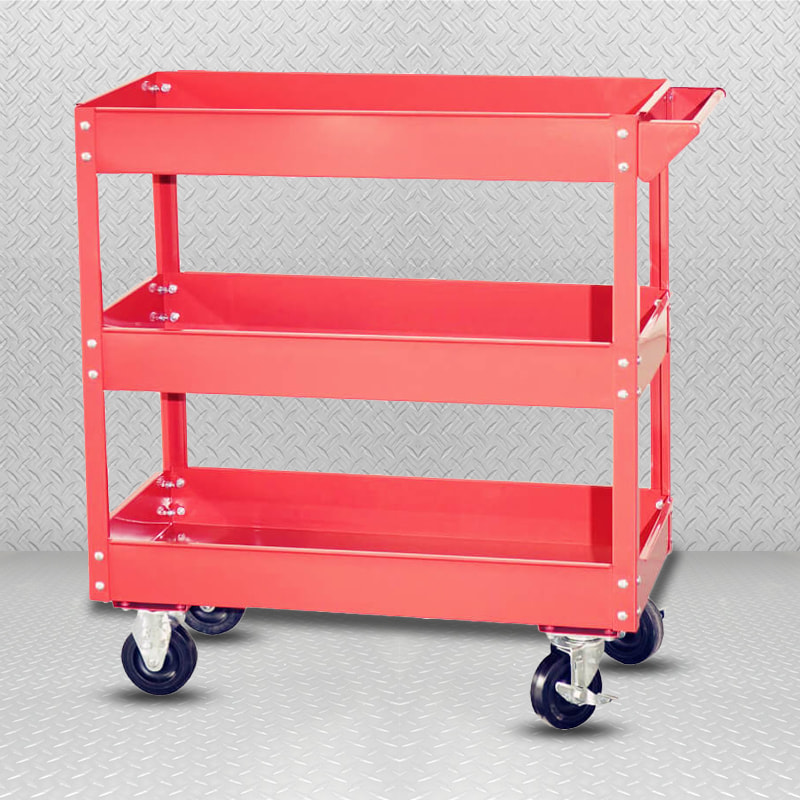The choice between lightweight materials and heavier, more durable materials in the construction of a multi-functional tool cart involves balancing several factors, each with its own set of benefits and trade-offs. Here's a breakdown of these considerations:
Benefits of Lightweight Materials:
Increased Mobility:
Easier to Maneuver: Lightweight materials, such as aluminum or certain high-strength plastics, make the tool cart easier to move around, especially in tight spaces or on uneven surfaces. This is particularly beneficial in workshops, garages, or job sites where frequent relocation is necessary.
Reduced Strain: The lighter weight reduces the physical strain on the user, making it more comfortable to push, pull, or lift the cart, which can be important for preventing workplace injuries.
Fuel Efficiency in Transport:
Lower Transportation Costs: If the tool cart is frequently transported by vehicle, the reduced weight can lead to better fuel efficiency and lower transportation costs, especially when moving multiple carts or heavy loads.
Flexibility and Versatility:
Adaptable Designs: Lightweight materials often allow for more innovative and versatile designs. For example, collapsible or modular tool carts are easier to achieve with lighter materials, offering greater flexibility for different tasks.
Corrosion Resistance:
Durability in Harsh Environments: Many lightweight materials, such as aluminum and certain plastics, are naturally resistant to corrosion, making them ideal for environments where moisture or chemicals are present.
Trade-Offs of Lightweight Materials:
Reduced Load Capacity:
Lower Strength: Lightweight materials typically have a lower load-bearing capacity compared to heavier materials like steel. This can limit the amount of weight the tool cart can safely carry, potentially requiring more frequent trips or the need for multiple carts.
Structural Integrity: Overloading a lightweight tool cart can lead to deformation, damage, or failure of the cart, reducing its lifespan and requiring more frequent replacements.
Stability Concerns:
Higher Tipping Risk: A lighter tool cart may be more prone to tipping, especially when carrying heavy or unevenly distributed loads. This can be a safety concern, particularly in dynamic work environments where the cart may be subject to sudden movements.
Vibration Sensitivity: Lightweight materials might not absorb vibrations as effectively, which can lead to tools shifting or falling during transport.

Benefits of Heavier, More Durable Materials:
Increased Load Capacity:
Higher Strength: Heavier materials like steel provide greater load-bearing capacity, allowing the tool cart to carry more tools and equipment without compromising structural integrity. This is crucial in industrial settings where heavy-duty tools are frequently used.
Longevity: The inherent strength of durable materials contributes to a longer lifespan for the tool cart, reducing the need for frequent replacements and offering better long-term value.
Enhanced Stability:
Lower Center of Gravity: The added weight of durable materials lowers the center of gravity of the tool cart, reducing the risk of tipping and enhancing overall stability, especially when loaded with heavy items.
Vibration Dampening: Heavier materials tend to absorb vibrations more effectively, helping to keep tools in place during movement and reducing noise.
Resistance to Damage:
Impact Resistance: Durable materials are generally more resistant to dents, scratches, and other forms of physical damage. This makes them ideal for rugged environments where the tool cart may be exposed to rough handling or accidental impacts.
Trade-Offs of Heavier, More Durable Materials:
Decreased Mobility:
Difficult to Maneuver: The increased weight makes the tool cart harder to push, pull, or lift, which can be a significant drawback in environments where the cart needs to be frequently moved or where space is limited.
User Fatigue: The added effort required to move a heavy tool cart can lead to user fatigue, potentially increasing the risk of injury or reducing productivity.
Higher Transportation Costs:
Fuel Inefficiency: If the tool cart needs to be transported by vehicle, the extra weight can lead to higher fuel consumption, increasing operational costs, especially for businesses that frequently transport heavy loads.
Corrosion and Maintenance:
Vulnerability to Corrosion: Heavier materials like steel may be more prone to corrosion if not properly treated, requiring regular maintenance to prevent rust and extend the lifespan of the cart.
Complex Maintenance: Heavier carts might require more effort and specialized tools to maintain or repair, particularly if parts need to be replaced or the cart needs to be disassembled.
The choice between lightweight and heavier, more durable materials for a multi-functional tool cart depends on the specific needs of the user. Lightweight materials offer increased mobility, ease of use, and corrosion resistance but may sacrifice load capacity and stability. In contrast, heavier materials provide greater strength, stability, and durability but can be more challenging to maneuver and may require more maintenance. Balancing these factors is key to selecting the right tool cart for the intended application.

 ENG
ENG  English
English Deutsch
Deutsch











 +86 (0)512-5297 3238
+86 (0)512-5297 3238 +86 (0)512-5297 3239
+86 (0)512-5297 3239 info@chinagoldenline.com
info@chinagoldenline.com  No.58, Yangguang Avenue, Yushan High-tech Industry Zone, Changshu City, Jiangsu, China.
No.58, Yangguang Avenue, Yushan High-tech Industry Zone, Changshu City, Jiangsu, China.

